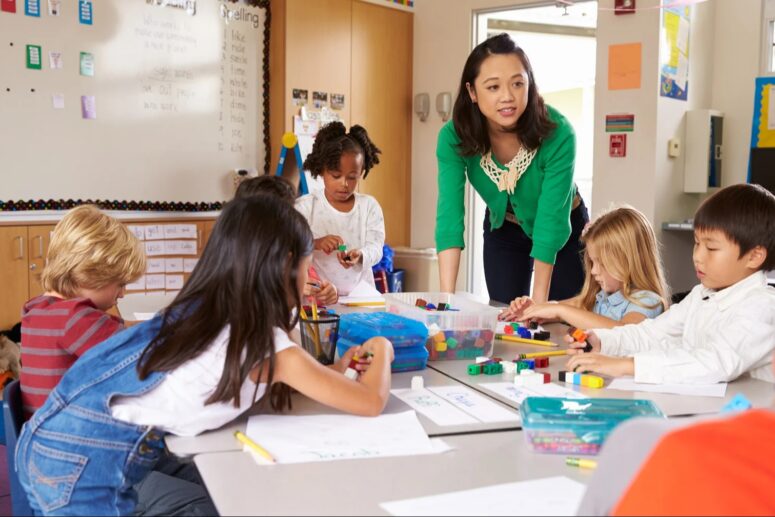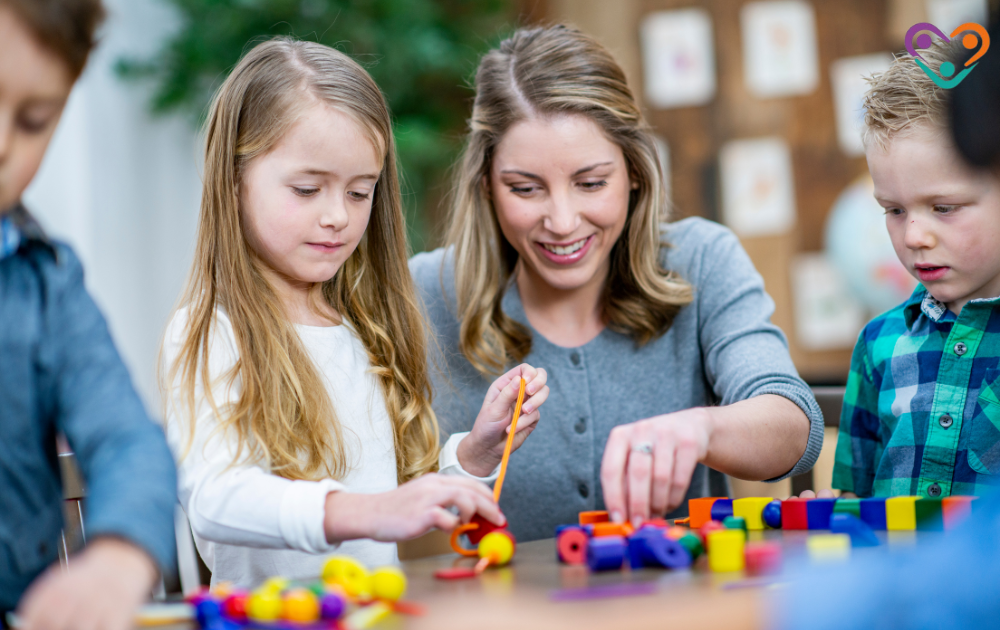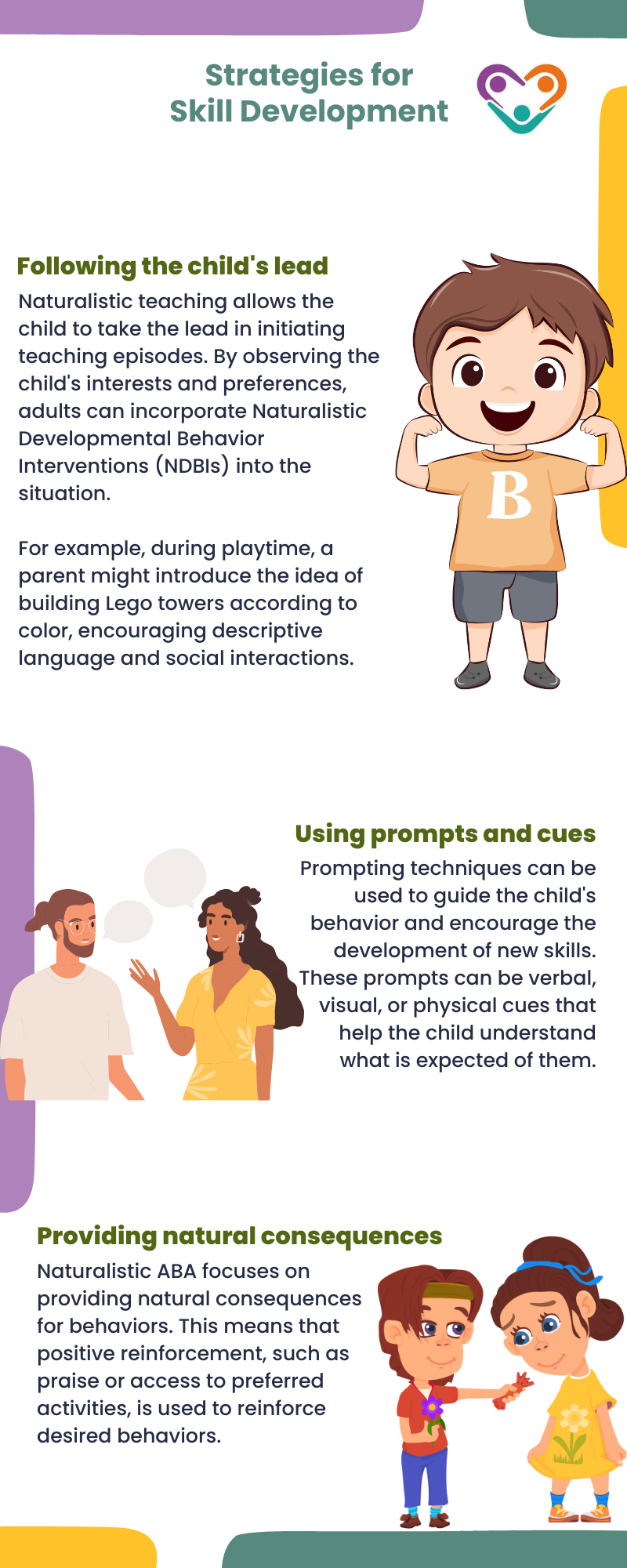
Table of Contents
Naturalistic ABA, also known as Naturalistic Intervention, is an approach within applied behavior analysis (ABA) that focuses on promoting skill development in individuals with Autism Spectrum Disorder (ASD) through natural and meaningful interactions. It encompasses various principles and techniques aimed at enhancing communication and social development.
Here, we’ll explore the principles of naturalistic intervention and its effectiveness and applicability.
Principles of Naturalistic Intervention
Naturalistic intervention is a collection of practices that involve environmental arrangement, interaction techniques, and strategies rooted in ABA principles. It is designed to create a supportive learning environment that fosters the development of skills in toddlers with ASD. In a way, you can say it shares some similarities with the Early Start Denver model.
The core principles of naturalistic intervention include:
- Individualization – Naturalistic ABA recognizes the unique needs and strengths of each child. The intervention is tailored to the specific requirements of the individual, taking into account their interests, preferences, and developmental level.
- Environmental Arrangement – The learning environment is structured to optimize opportunities for skill development. This involves arranging the physical space, materials, and activities to encourage engagement, interaction, and learning.
- Child-Led Interactions – Naturalistic intervention emphasizes following the child’s lead during interactions. This approach allows the child to initiate activities and communication, promoting their motivation and engagement in the learning process.
- Incidental Teaching – Incidental teaching is a key component of naturalistic ABA. It involves capitalizing on naturally occurring opportunities within the child’s environment to teach and reinforce targeted skills. This approach helps to generalize skills across different contexts.
Effectiveness and Applicability
Naturalistic intervention has shown effectiveness in promoting skill development in toddlers with ASD. It is suitable for children of various cognitive levels and can be implemented in any setting where the child spends time. This includes home, school, therapy centers, and community settings.
Naturalistic intervention can be carried out by parents and other appropriately trained adults who have received training in the intervention processes.
Research supports the effectiveness of naturalistic ABA in enhancing communication and social skills in toddlers with ASD. A study of 10 single-case design studies demonstrated that naturalistic intervention meets the evidence-based practice criteria in the birth to elementary age groups.
The flexible and individualized nature of this approach allows for targeted skill acquisition within daily routines and activities, increasing the potential for generalized learning.
How Naturalistic ABA is Implemented
To effectively implement naturalistic ABA, there are various aspects to consider, including the settings and participants involved, strategies for skill development, and promoting generalization of learned skills.
Settings and Participants
Naturalistic ABA can be implemented in various settings where a toddler spends time, such as in homes, schools, and therapy centers. The goal is to support the acquisition of target behaviors in communication and social development. Parents, caregivers, therapists, and teachers can all play a role in implementing naturalistic ABA.
By working together, they can create an environment that fosters learning and skill development.
Strategies for Skill Development
One of the key aspects of naturalistic ABA is strategically eliciting and expanding upon responses that occur during everyday routines and activities. This approach enhances communication and social skills by integrating teaching moments into naturally occurring situations.
Some strategies for skill development in naturalistic ABA include:
Promoting Generalization
Generalization refers to the ability to apply learned skills across different settings, people, and situations. In naturalistic ABA, promoting generalization is a crucial aspect of the intervention. The goal is for the child to be able to use the skills they have learned in various contexts.
Some strategies for promoting generalization include:
- Varying the environment – It is important to expose the child to different environments and settings to ensure they can generalize their skills beyond specific contexts. This can be achieved by introducing new play settings, involving different people, and engaging in various activities.
- Practicing skills in different situations – By intentionally practicing skills in different situations, the child learns to transfer their knowledge and abilities to new contexts. For example, if a child has learned a social communication skill during a therapy session, they can practice using that skill during a playdate with peers or while engaging in a family outing.
- Collaborating with others – Collaboration between parents, caregivers, therapists, and teachers is essential for promoting generalization. By sharing information and strategies, everyone involved can reinforce consistent expectations and encourage the child to apply their skills across different environments.
Implementing naturalistic ABA requires a collaborative effort and a focus on individualizing the intervention to meet the needs of the child.
By creating a supportive environment, using effective strategies for skill development, and promoting generalization, naturalistic ABA can effectively enhance communication, social skills, and adaptive growth in children with autism.
Techniques in Naturalistic Teaching
Naturalistic ABA (Applied Behavior Analysis) uses several techniques to facilitate skill development and language acquisition in individuals with autism. These techniques focus on creating a natural learning environment and maximizing motivation.
These commonly used techniques are as follows:
Incidental Teaching
Incidental teaching (IT) is a naturalistic approach initially developed in the late 1960s for disadvantaged children and has since been adapted for children with autism. During an IT episode, a trainer integrates desired objects or activities into a natural setting, creating opportunities for the child to engage and interact with the objects.
The child is encouraged to initiate contact related to the object, which helps enhance language skills and promote learning.
The key principle of incidental teaching is to follow the child’s lead and capitalize on their interests to facilitate learning. By embedding learning opportunities into the child’s natural environment, incidental teaching promotes the generalization of skills beyond structured therapy sessions.
Mand-Model Procedure
The mand-model procedure is a modification of incidental teaching that focuses on generalizing previously acquired language skills in children with autism. The objective of this technique is to encourage the child to initiate verbal responses in various situations.
In the mand-model procedure, the therapist initiates the interaction by presenting a desired object or activity. The therapist then prompts the child to respond by modeling the desired verbal response.
When the child produces the correct response, they are rewarded with access to the desired object or activity. This procedure helps reinforce the child’s language skills and encourages them to use language spontaneously.
Here’s a more detailed explanation of this method:
Natural Language Paradigm
The natural language paradigm (NLP) is a technique that aims to enhance the quality and quantity of language in children with autism. NLP integrates the child’s motivation and interests into effective teaching strategies. This technique relies on reinforcement to increase motivation and engagement during learning activities.
The focus is on identifying what motivates the child and using those motivators to facilitate learning. This may involve incorporating preferred toys, activities, or topics of interest during teaching sessions.
Remember that every child is unique, and progress may vary. Celebrate small victories, be patient, and provide ongoing support throughout the journey. With the right approach, consistent implementation, and the support of ABA specialists, parents and caregivers can effectively incorporate naturalistic teaching into their daily lives.
Sources:
https://www.appliedbehavioranalysisedu.org/how-is-naturalistic-teaching-used-in-aba
https://www.autismparentingmagazine.com/naturalistic-teaching-support-children
https://www.appliedbehavioranalysisprograms.com/faq/what-is-naturalistic-teaching
https://tbh.com/blog/art-of-naturalistic-teaching
https://asdtoddler.fpg.unc.edu/book/export/html/252.html
- Autism Routine Disruption in Adults: Coping Tips - July 16, 2024
- Autism and Obsession: An Overview - July 16, 2024
- Autism and Taking Clothes Off: Management Tips - July 16, 2024




